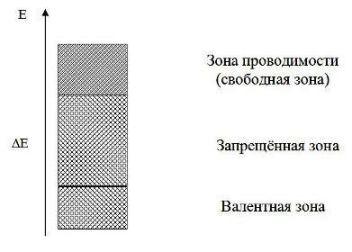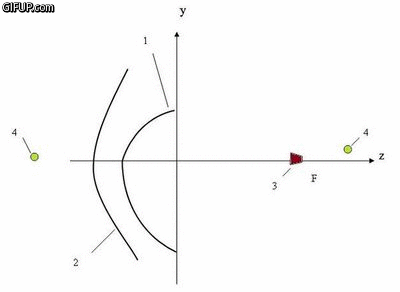Sinopsys for the graduating work "The research of antennas with electronic scanning"
Contents
3. The Method of Electronic Scanning of Radiation Pattern Using Properties of Reversible Material
Main Information
The purpose of work is to review of reversible material in antenna technology, in the development of method of electronic scanning of radition pattern of reflecting antennas, based on their properties.
The object of research is the method of scanning of radition pattern of reflecting antennas for solving the problem of determining the direction to the radiation source or direction on several sources of radiation in the environment, getting the desired shape and width of the radiation pattern of antenna in microwave frequencies, as well as manage radiation pattern during the scanning process for a given law.
The new thing in the work is using new material and combining different antennas in one system in antenna technique.
The result of the work is the proposed method for a given shape and width of radition pattern of the antenna at microwave frequencies, as well as a way to control the radiation pattern of antenna during the scanning process for a given law.
Keywords: reversible material, electronic scanning, reflector antenna, scan of radiation pattern, radar.
Introduction
Integral part of modern radio equipment are antenna systems.
Thus, at this stage, the antenna from a simple means of increasing the range of radio communications becomes in determining the radio link. Limit the capabilities of modern radars in range and accuracy of direction-finding purposes, limiting sensitivity and resolution of radio telescopes, limit range radio communication in space with remote objects, and many other features different radio systems are defined technically achievable parameters of antenna devices in the first turn - beam width [5].
Currently antenna technology has reached a level of maturity and its development in recent years is in largely through the creation of fundamentally new types of antennas, and by improving their performance and introduction of new methods of their use. The appearance of new ideas in the field of antenna technology driven by the needs of a radio system with one or other specified characteristics [1].
In this work, I research the possibility of using reversing material in antenna technology in order to improve the performance of antenna systems, the desired shape and width of the radiation pattern of antennas at microwave frequencies. And the management of radiation pattern of antennas during the scanning process for a given law [2].
The Method of Electronic Scanning of Radiation Pattern Using Properties of Reversible Material
In this work the method of electronic scanning of radiation patterns of reflecting antennas base on the property of the antenna reflector made of reversible material. Feature of reverssble material is in the fact that in the initial state, it is Radar, and when exposed to her control signal it acquires the properties of the reflecting surface.
We know that the structure of the energy spectrum is the main factor which determines the electroconductivity of some substances.
Dielectrics have a wide forbidden gap, that’s why transition of the electrons to the conducting band while the influence of the thermal excitation is impossible.
Metals do not have the forbidden band.
Semi-conductors have the forbidden band of 0.01 – 5 electronvolt in width. When the temperature is low and the power supply is absent, the semi-conductor does not conduct current, i.e. it is an insulator. When energy is supplied from outside, for example, while heating a crystal, there appears the possibility of the electrons transfer from the valence band to the conducting band [3].
The insignificant amount of admixture added to the pure semi-conductor can dramatically increase its electroconductivity. Its nature changes while the temperature is growing. As a result, the electroconductivity takes on mixed nature. While the temperature is growing, impurity levels weaken.
Finally, at the certain temperature the electrons transfer only from the valence band to the conducting one. The increase of the admixture concentration in the semi-conductor decreases the size of the transition region between the impurity conductance and self-conductance. While the further increase of the admixture share, the energy of the active impurity center decreases. At some level of concentration it turns into zero, i.e. the semi-conductor becomes a semimetal. Such materials, when they experience low temperatures, show the features of metals; when the temperature is high, they show the features of dielectrics. Thus, the semi-conductor saturated with the admixtures can be used as the reversing material which is conducted by the temperature [2].
We can see the similar effect when the semi-conductor is influenced by the light or electronic ray. While the constant temperature and absence of evolving, the electroconductivity of the pure semi-conductor or impure semi-conductor is called the dark conduction. After lighting the semi-conductor by some light with the energy of the photons, which is higher than the width of the forbidden gap of the pure semi-conductor or higher than ionization energy of the impure semiconductor, the additional nonequilibrium carrier of the charge appears in the conducting band.
As a result, the electroconductivity of the semi-conductor grows. The appearance of the photo-carrier causes the local changes of all the electromagnetic parameters of the material, such as reflection, refraction and transmission coefficients of the electromagnetic wave. Under the absence of light, the reversible materil possesses the small dark illumination and it is the radioparent medium [1].
We offer the method of scanning, which is based on the lighting the surface of the reversible material with the intensive light spot of the necessary size and shape. Changing this size leads to changing the width of the radiation pattern and its shape in the given plane. It is obvious that the width of the radiation pattern of the antenna depends on the size, shape and orientation of the light spot, e.g. it becomes narrower with the growth of the light spot. During the transference of the light spot on the surface of the reflector, we implement scanning of the radiation in the space [3].
At the same time, the speed of scanning is limited only by the transmission speed of the reverssble material from the non-conducting state to the conducting, i.e. it is determined by the life time of nonequilibrium carriers of current, and by the speed of the light spot transfer; the rule of shift of the light spot disposition, as well as the directional diagram, can be arbitrary [2].
Thus, this method both makes it possible to generate the radiation pattern with the given form and width in the microwave range and to command the radiation pattern while we are scanning, using the adjusted rule, that ensures the trajectory flexibility and the scanning high speed [3].
Semi-conducting material has to meet to some special demands including time lag, spectrum characteristics and mechanical properties. Moreover, it has to have the high amplitude and phase uniformity [4].
The next figure shows one of the results - multi-beam scanning antenna reflector. This antenna is made of radiotransparent substance and covered with a thin layer of reversible material. When exposed to a source of control signals, it generates a sequence of two types of radiation pattern: a fan and a special type (cosecans), which enables use this antenna in the radar for a review of space and tracking of moving objects.
The picture type is an аnimation;
format: gif;
size: 400х292 pixels, 50.7 Кb;
number of slides is 3;
delay of one slide is 1 sec.;
made by online "Gif Animation Maker"
www.gifup.com.
The Bibliographic List
1. Вайнберг И.А., Павельев В.А. Исследование амплитудно-фазовой структуры ближнего поля антенны СВЧ при помощи фотоуправляемых полупроводниковых панелей. Радиотехника и электроника, - М.: Наука, 1971. №9 – 685 с.
2. Вайнберг И.А., Вайнберг Э.И., Павельев В.А. Индикация структуры электромагнитного поля при помощи неравновесных носителей тока в полупроводниках. Радиотехника и электроника, - М.: Наука, 1971. №3 – 371 с.
3. Волькенштейн Ф.Ф. Электроны и кристаллы. – М.: Наука, 1983. – 128 с.
4. Зуев В.А., Саченко А.В., Толпыго К.Б. Неравновесные приповерхностные процессы в полупроводниках и полупроводниковых приборах. - М.: Советское радио, 1977. – 256 с.
5. Марков Г.Т., Сазонов Д.М. Антенны. Изд. 2-е, перераб. и доп. - М.: Энергия, 1975. – 528 с.
6. Нашельский А. Я. Технология полупроводниковых материалов, – М.: Наука, 1973.
7. Патент № 49709, Украина, МПК (2009) H01Q19/10. Многолучевая зеркальная сканирующая антенна. Донецкий национальный технический университет. Паслён В.В, Федотова (Доронина) М.В., Михайлов М.В., Михайлова А.В., Иваницин В.Е., Вахнова Е.Е. Публ. – 11.05.2010. Бюл. №9 – 8 стр.
8. Сазонов Д. М. Антенны и устройства СВЧ, - М.: Высшая школа, 1988. – 432 с.
9. Спиридонов Н.С. Основы теории транзисторов. - К.: Технiка, 1969. – 300 с.
10. Федотова (Доронина) М.В., Барабаш Ю.С., Паслён В.В. Формирование диаграммы направленности специальной формы в зеркальных антеннах // Материалы XIII Международного молодёжного форума «Радиоэлектроника и молодёжь в XXI веке». – Харьков: ХНУРЭ, 2009 - с. 35.
11. Федотова (Доронина) М.В., Барабаш Ю.С., Паслён В.В. Формирование диаграммы направленности специальной формы в зеркальных антеннах // Материалы XI Международной молодёжной научно-практической конференции «Человек и космос». – Днепропетровск: НЦАОМ, 2009.
12. Федотова (Доронина) М.В., Паслён В.В. Антенны специального назначения // Материалы XIV Международного молодёжного форума «Радиоэлектроника и молодёжь в XXI веке». Сборник тезисов. – Харьков: ХНУРЭ, 2010 - с. 25.
13. Федотова (Доронина) М.В., Паслён В.В. Диаграммы направленности специальной формы // Материалы XII Международной молодёжной научно-практической конференции «Человек и космос». Сборник тезисов. – Днепропетровск: НЦАОМ, 2010 - с. 418.
14. Федотова (Доронина) М.В. Многолучевая зеркальная сканирующая антенна // Материалы 6-ой Международной молодёжной научно-практической конференции «Современные проблемы радиотехники и телекоммуникаций РТ - 2010». Сборник тезисов. - Севастополь: СевНТУ, 2010 - с. 196.
15. Доронина М.В. Зеркальная сканирующая антенна // Материалы 7-ой Международной молодёжной научно-практической конференции «Современные проблемы радиотехники и телекоммуникаций РТ - 2011». Сборник тезисов. - Севастополь: СевНТУ, 2011.
16. Филькенштейн М.И. Основы радиолокации. Изд. 2-е, перераб. и доп. - М.: Радио и связь, 1983. – 536 с.
17. Хорхордин А.А., Носко Ю.В., Паслен В.В. О возможности использования реверсивных сред в антенной технике / Международная научно-практическая конференция «Человек и космос»: Сборник тезисов. – Днепропетровск: НЦАОМУ, 2004. – с. 296.
18. Absteract «Зеркальные антенны» on a site "gardenweb.ru".
The abstract is under construction. This above option is not final. The final version will be finished in December, 2011.


